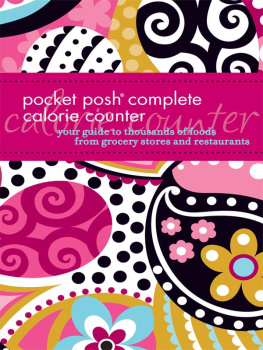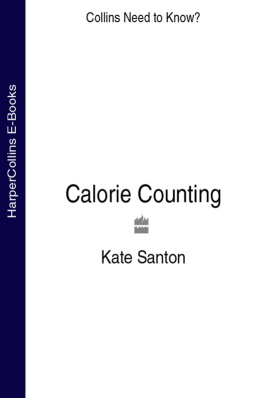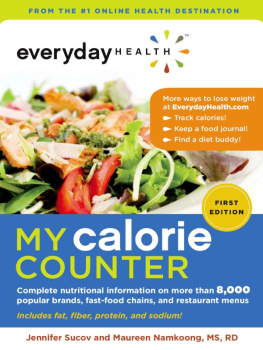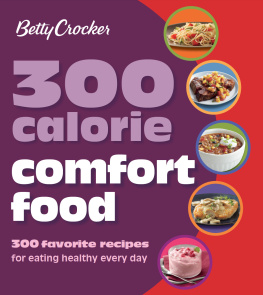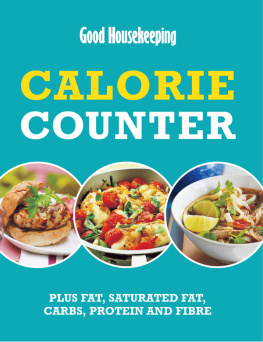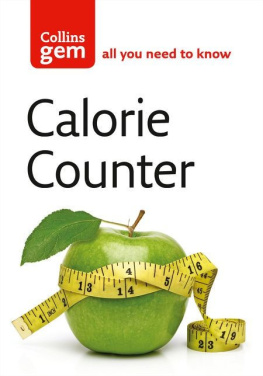
Produced by

| President | Julie Merberg |
| Senior Vice President | Patty Brown |
| Layout by | Jennifer Richman/Richman Creative Group |
| Special Thanks | Sarah Parvis, LeeAnn Pemberton,
Pam Abrams, Felicia Stoler, Jenna Bell,
Maggie Moon, Kristen Carlucci, Dina Aronson |
POCKET POSH COMPLETE CALORIE COUNTER
Copyright 2010 by Downtown Bookworks, Inc. All rights reserved. No part of this book may be used or reproduced in any manner whatsoever without written permission except in the case of reprints in the context of reviews. For information, write Andrews McMeel Publishing, LLC, an Andrews McMeel Universal company, 1130 Walnut Street, Kansas City, Missouri 64106.
E-ISBN: 978-1-4494-0621-9
Library of Congress Control Number: 2010934819
www.andrewsmcmeel.com
ATTENTION: SCHOOLS AND BUSINESSES
Andrews McMeel books are available at quantity discounts with bulk purchase for educational, business, or sales promotional use. For information, please write to: Special Sales Department, Andrews McMeel Publishing, LLC, 1130 Walnut Street, Kansas City, Missouri 64106.
Cover Illustration by robandbobstudio.com

Contents

preface
Knowing whats in your food is essential to making better choices to reach and maintain a healthy weight. The challenge is that with so many choices in grocery stores and restaurants today, its impossible to instinctively know just how nutritious (or not) many foods are. In a lot of cases, a handful of very similar products can have wildly different amounts of calories or sodium, for example. Thats what makes this book an invaluable companion.
Notable exceptions are fresh fruits and vegetables, which are always healthy choices. The simple goal to include a fruit or vegetable every time you eat, whether its a meal or snack, is a smart way to get into the habit of eating a nutrient-rich diet. Theres also a good chance that youll naturally be taking in fewer calories, saturated fats, and sodium and a whole lot more fiber,vitamins, and minerals.
A well-balanced diet will also include whole grains, lean proteins, and good fats. For all of these foods and everything in between, knowing what you put in your body is going to help you balance your calories in with your calories out.
I hope you make the most of this pocket guide to help you keep track of what you eat and that youll feel empowered to make better choices for your waistline and your overall health and well-being.
Eating right really works, and I am honored that youve picked up this book as an important part of getting there. Heres to a healthier you.
D. Milton Stokes, MPH, RD

introduction
Healthy Weight Fundamentals
Reaching and maintaining a healthy weight is about balancing calories in with calories out. Calories are a way to think about the amount of energy you get out of food and the amount of energy your body burns during exercise.
Protein and carbohydrates provide 4 calories per gram.
Fat provides 9 calories per gram.
Walking for 5 minutes burns about 15 calories; sleeping burns about 1 calorie per minute.
To lose weight, you have to burn more calories than you take in. This is not groundbreaking news, but it certainly can be challenging to put into action. In addition to keeping track of calories by using this pocket guide, here are seven tips to living healthfully:
1. More produce. Eat lots of vegetables and fruits in a variety of colors, without added sugars, fats, or salt. Fresh, roasted, and sauted are healthier ways to enjoy these foods.
2. Good carbs. Choose better carbohydrates from high-fiber foods such as whole grains, beans, and vegetables over refined grains and fried potatoes. Better carbohydrates can also be found in fruits and low-fat dairy products.
3. Proteins to prefer. Pick healthy proteins from plant sources such as beans, nuts, and soy products. Seafood also offers good protein choices. If including poultry and meat, choose lean types and roast, bake, broil, poach, or saut.
4. Healthy fats. Dont be afraid of healthy fats from unsaturated sources such as liquid oils (e.g., canola oil, vegetable oil, olive oil) and foods such as avocado, salmon and other fatty fish, nuts, and whole grains. Do limit saturated fats and avoid trans fats.
5. Stay hydrated. Drink water and tea to stay hydrated. Enjoying fruits and vegetables with high water content also contributes to hydration. Some examples are cucumbers, watermelon, grapefruit, celery, peppers, and tomatoes.
6. Get moving. Move more, every day. Look for opportunities to work physical activity into your day. If its hard to find time to get to the gym, join a sports team or take a dance class. Look for other ways to move more: Take the stairs, take a walk, lift weights during commercial breaks where theres a will, theres a way.
7. Track and assess. Keep track of how youre doing in a diet and exercise journal. See how youre doing compared to your goals, making adjustments where theres room for improvement. Simply being more aware of what youre eating every day is doing something right for your health.
Carbohydrates to Love
Our bodies love carbohydrates. Whats not to love? Theyre the preferred fuel source for the brain; we can use them for energy now or store them for energy later; some provide dietary fiber; and we can get them from a variety of whole grains, fruits, and vegetables.
Fruits and Vegetables
Aim for 2.5 to 4.5 cups of fruits and vegetables every day, and go a little heavier on the vegetables.
Give them a center-of-plate role in your meals and snacks.
Mix it up and choose from green, yellow, orange, red, purple, and white fruits and veggies to get the most out of the different vitamins, minerals, antioxidants, and other phytonutrients they have to offer. Deeper in color often means richer in nutrients.
Fresh fruits and veggies are delicious and will be most affordable when theyre in season for your local area.
Frozen fruits and veggies are often flash-frozen to retain flavor, quality, and nutrients. Theyre a great choice. Just be sure to flip the package around to the Nutrition Facts Panel to make sure theres no added salt or sugar.
Canned fruits and veggies are good to have in the pantry (canned and jarred tomato products come to mind). However, because they often come with added sugar, salt, and preservatives, seek out fresh and frozen before canned.

